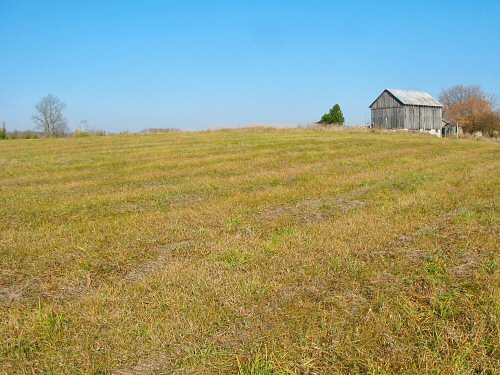
A third trip to the new farm, with more tiny farming conversation and checking things out. The weather: beautiful once again. The view in the pic: a perfectly south-facing slope (when you’re thinking about growing, pictures of promising farmland never fail to excite!). The benefits of a gentle SFS are well-known, and they’re particularly precious in a climate like ours, with harsh, snow-bound winters and a relatively short summer growing season. A slope facing south receives sunlight much more directly than flat land, so the snowpack is much lighter during winter, and more quickly melted off in spring. Then, the soil warms up more quickly, and gravity does its thing, providing better drainage, allowing the ground to dry out more quickly. All around, this simple incline could provide a couple of weeks of spring headstart, compared to flat land right beside. How well this actually pans out will be fun to see!




I’ve read about it, and I’ve dreamt about it. Congrats on what sounds like a great piece of land. What an adventure!
Nate
http://slcveggies.blogspot.com
I know of this concept well. Although you could not call my area a farm or even a veggie patch (4-4×4 beds) it is located on the south side of the house right against the foundation. There is an area about 1.5 feet wide along the foundation that can almost be worked year round.
I have a question if you have a moment: Did your decision to start your farm have anything to do with our possible energy crisis down the road?
Dan: No, tiny farming for me was something I (happily) stumbled into six years ago. There was absolutely no pre-thought or planning. It was literally from one week to the next. Nowadays, I often think that all my life of city living, I was unconsciously looking for small-scale farming, for the many reasons I love it, including the striving to be as sustainable and self-sufficient as possible.
I heard something once that I would like to confirm or learn the source of. It was that gardening on a south-facing slope of 10 degrees or 10% ( I can’t remember which – and there is a difference) was the equivalent of having your garden located 300 miles further south. Can anyone help me with that?
Yes, a south-facing slope warms up significantly faster than a slope in any other direction or than flat land. The origin of what you are referring to may be Eliot Coleman’s The New Organic Grower: “Land in the Northern Hemisphere at about 45° latitude that slopes 5° to the south is actually in the same solar climate as level land 300 miles to the south.” A rough equivalency calculation for location and degree of slope sounds straightforward; I don’t know what it is. A south-facing slope can also be too much of a good thing if plants develop too fast in a cold climate, and then get caught in a frost, so the greater the advantage, the more you have to watch your crop selection and timing. I’ve never specifically taken advantage by planting much ahead on a south-facing slope, but it’s easy to see that, depending on location and overall weather, you could gain a week or two at least.